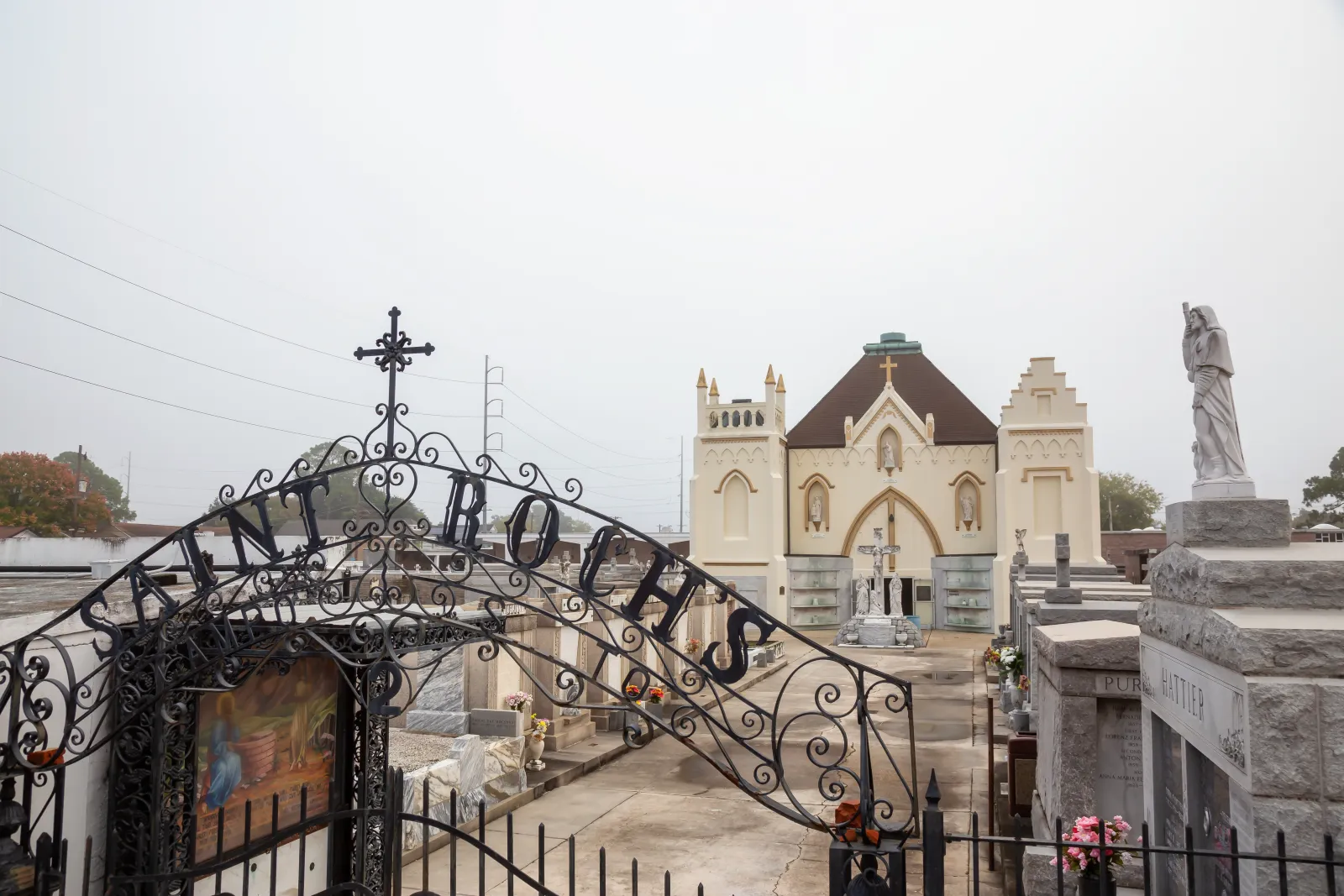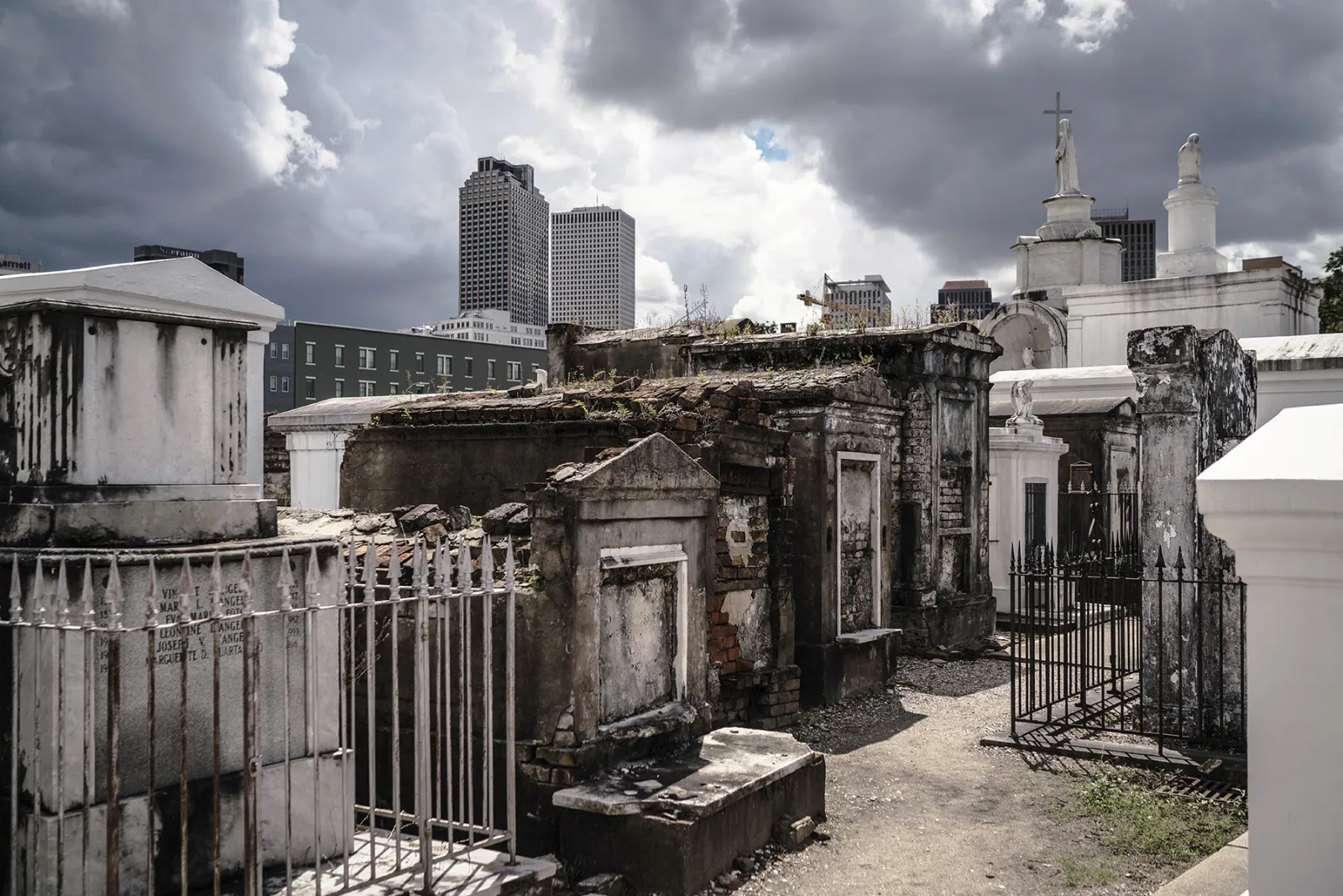There's just something intriguing about a cemetery, in all its creepy splendor, that feeds into the human fascination with the unknown and our attraction to the macabre.
But while the usual U.S. cemetery, with its typical tombstone-covered rolling green lawns and underground tombs, has simply been done to death, there is something unusual and unique about New Orleans cemeteries. Above-ground tombs, decorative statues, ornamental mausoleums, and white limestone vaulted walls help give these iconic "Cities of the Dead" their drop-dead gorgeous appearance. Because of this, local cemeteries, as well as the tombs of certain people buried in them—such as Marie Laveau, Ernie K-Doe, and Danny Barker—are a huge draw for tourists. The New Orleans Marketing Corporation reported that 42% of out-of-towners are dead-set on checking out one of the over 30 historic cemeteries when they're in town.

Dead in the Water
When New Orleans was first settled in 1718, life here was rough. There was disease and difficulty, storms and starvation, and one thing was dead certain: people were going to die. Likely very many of them. And those they left behind needed a place to dispose of the bodies.
The first cemetery in the city was built in approximately 1725, dead-center in the middle of the French Quarter, along St. Peter Street, and dead bodies were buried there underground. There were several reasons why anyone who thought this was a good plan was dead wrong.
First, the water table in New Orleans is so high, especially back in those days, that digging down even a few feet usually meant striking water. Coffins buried in these watery graves tended to get soaked to death, and the water pressure was strong enough to literally raise the dead—often forcing the coffins right up out of the ground again. Some funerary experts tried using rocks in the pine boxes as dead weight, but it wasn't enough to keep them down.
As New Orleans was developed, real estate began to be as much of a hot commodity then as it is today. Not only did people want to use the land where St. Peter Cemetery lay to build stores and residences, but when the yellow fever epidemic of 1788 killed thousands, it became clear that a much bigger cemetery was needed.
Over Their Dead Bodies!
The surplus of yellow-fever-stricken dead bodies was too much for the overcrowded St. Peter Cemetery to handle. Sanitation became an issue among the decaying of the stricken, and many locals were scared to death that the dead were still contagious to the living and that the air around these corpses was infected. Yet no one agreed on an appropriate method of disposal. Finding a place to stash these remains was becoming something of a bone of contention.
St. Peter Cemetery was officially closed in 1800, and the city was built up directly atop those grave sites. In fact, in a fairly well-known recent incident, 15 coffins were dug up in 2011 when a man living on that same block of the French Quarter decided to put in an in-ground swimming pool in his backyard.
A Matter of Life and Death
It was enforced by law that all new cemeteries would be built outside the city proper, as most residents didn't much care for living near death's door. In 1789, St. Louis Cemetery No. 1 opened just beyond the French Quarter on Basin Street, where it remains today. And speaking of remains, this cemetery comprises of more than 600 tombs and monuments, as well as the human leftovers found within them. St. Louis No. 1 is the oldest still-existing cemetery in New Orleans, as well as the most frequented (by the living), bringing in thousands of visitors each year.

At first, people continued to bury the dead underground even in the new cemetery, but by 1804, they began to realize that above-ground tombs were a solution for the groundwater problem, keeping corpses relatively bone-dry by comparison. These tombs also followed the burial customs prevalent in Southern France and Spain, where many early New Orleanians hailed from.
Fancily decorated above-ground tombs soon became a symbol of wealth and a way for well-to-do New Orleans residents to show off their social standing. So while the rich were dying to get into cemeteries such as St. Louis Cemetery No. 1, they wouldn't be caught dead in some of the mass graves and "potter's fields" where the bodies of the less fortunate where dumped.
Clown Cars of the Dead
In any one of these New Orleans graves, there could be many people resting within—perhaps dozens or, in larger tombs, even hundreds. The way that they manage to stuff so many dead folks into such a small space is through a long-standing and elaborate burial process that is still used today. The grave is opened, and the casket is slid into the vault. To make room for the newcomer, the casket containing the previously departed is removed and whatever scraps remain of that body (usually just bones) are dumped into a hole in the floor. This corpse-compacting ritual continues for multiple burials until maximum capacity is reached. All fellow tomb-mates are connected by blood or by common interest—either family members or members of a particular social group, club, or organization.
It is a requirement that no tomb be opened between burials for at least a year and one day, to allow time for the resting-in-peace to properly decompose before a new resident moves in. The tombs are also not air-tight, allowing air to get in and speed up the decaying process. If anyone else related to, or otherwise affiliated with, the deceased should die during the prerequisite year-and-a-day waiting period, he or she will be temporarily deferred and stored in a holding crypt elsewhere, until Uncle Frank or Cousin Louie finish decomposing and free up a spot in the tomb.
Grave Danger
Burial in these community crypts could be risky business. In some instances, a family would have to pay rent for a space in a tomb to store a dead relation. If they defaulted on the rent, they risked having their half-decayed loved ones abruptly removed from their resting places. For impoverished families who had no other options, being stuck with a homeless carcass was a fate worse than death.

